Antalya Travel Guide: 10 Fascinating Ancient Cities to Visit
Located at the intersection of the ancient regions of Lycia, Pamphylia, Pisidia and Cilicia, Antalya is not only a natural beauty spot but also an open-air museum with its fascinating ancient cities that bear witness to human history. While the city is often known as a holiday destination centred around the sea, sand, and sun, its historical depth and cultural diversity take visitors on a journey through time with every step. In this unique geography, where the lush green cover of the magnificent Taurus Mountains meets the deep blue waters of the Mediterranean and the golden yellow rays of the summer sun, it is possible to enjoy a holiday intertwined with traces of the past. These ancient cities scattered throughout Antalya attract attention not only with their architectural wonders but also with the mythological stories, heroic legends and cultural riches they contain.
So, what are the must-see ancient cities in Antalya? Let's explore together!
1. Perge Ancient City
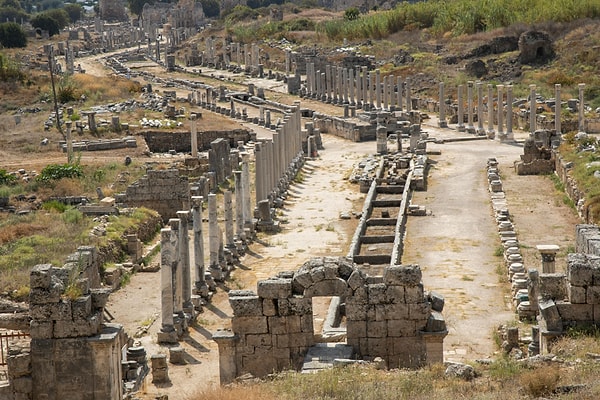
Located within the borders of Aksu district in Antalya, Perge dates back to the Hittite period and was known as ‘Parha’ in ancient times. One of the capitals of the ancient Pamphylia region, this city became a cultural, artistic and commercial centre during the Roman Empire. In particular, the orderliness of its urban planning, the sophistication of its architecture and the aesthetic quality of its works of art are important features that distinguish Perge from other ancient cities in the region.
The 15,000-seat theatre that greets you upon entering the city is almost intact and still capable of hosting events thanks to its acoustic structure. In addition, Perge, which also hosts an impressive 12,000-seat stadium, provides important clues about social life in ancient times.
Architectural elements such as grand collonaded streets, an agora (marketplace), baths, monumental fountains, city gates, and waterways demonstrate that this city was built in a planned manner and with great engineering success. Perge also holds a special place in Christian history, as it is known as the site where Saint Paul preached. One of the most impressive aspects of the city is the works of art created by famous sculptors. Many of these sculptures can be seen today in the Antalya Museum.
2. Side Ancient City
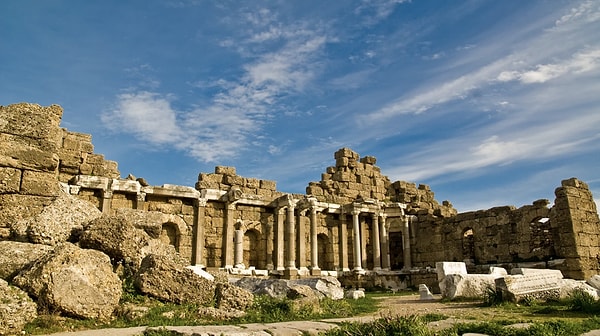
Side, located on a peninsula extending towards the sea and affiliated with the Manavgat district of Antalya, was one of the most important port cities of Pamphylia in ancient times. This city, which began to be settled in the 7th century BC, became an important trade and cultural centre over time.
During Alexander the Great's campaign in Anatolia, the city's inhabitants welcomed him, and thanks to this friendly approach, Side was introduced to Hellenistic culture at an early stage. The city became a coin minting centre in the 2nd century BC and achieved great economic power during this period.
Thanks to its strategic location on the peninsula, Side was of great importance in terms of both trade and defence, and it continued to be important during the Roman and Byzantine periods. The city's great gate, monumental streets, agora, baths, columned roads and theatre allow you to walk through history as you explore Side. The 20,000-seat theatre showcases the splendour of Roman architecture, while the ruins of the temples dedicated to Apollo and Athena offer breathtaking views at sunset.
In addition, the ancient city of Side is now intertwined with a modern holiday resort. This feature allows visitors to enjoy both the sea and cultural excursions at the same time.
3. Aspendos Ancient City
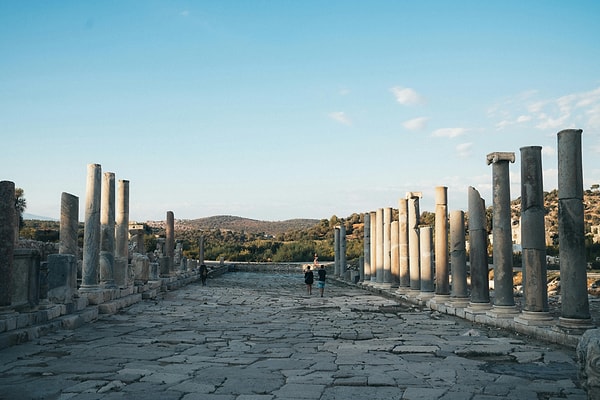
Located within the boundaries of Serik district, on the banks of the Köprüçay (formerly known as Eurymedon) River, Aspendos is particularly known for its magnificent theatre. Built during the reign of Roman Emperor Marcus Aurelius, this theatre is considered the best-preserved ancient theatre in the Mediterranean, with a capacity of 20,000 and exceptional acoustics.
Dedicated to the gods and emperors of the era, the theatre is a pinnacle of the art and engineering of its time, with its detailed decorations, stage building and seating arrangement. Not only the theatre, but also Aspendos' water engineering structures are noteworthy. The approximately 1 km long arched aqueduct, with its pressure towers at both ends and pear-shaped cisterns, showcases the advanced engineering knowledge of the ancient period.
In Aspendos, you can also see the agora, basilica, council building (bouleuterion), monumental fountain, and remains of a Hellenistic temple. It would not be wrong to say that the city is an open-air classroom for visitors interested in both the performing arts and the history of engineering.
4. Xanthos Ancient City
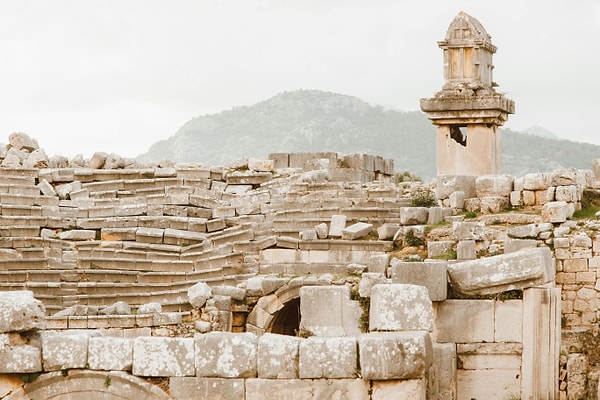
Located in the fertile valley irrigated by the Esen River (ancient Xanthos River) near the district of Kaş, Xanthos is of great importance as one of the administrative and religious centres of the Lycian Federation. The city has gone down in history for its people's love of freedom and independence. When besieged by the Persians in the 6th century BC, the dramatic accounts of the Xanthians collectively choosing suicide have become a symbol of these people's love of freedom.
Xanthos, which is on the UNESCO World Heritage List, also stands out for its unique Lycian architecture and written documents. The inscription on the monumental tomb located northeast of the city's agora, which dates back to the 5th century BC, is considered the longest written document in the Lycian language.
The ancient city of Xanthos reflects the unique urban planning of Lycia with its rock tombs, sarcophagi, monuments and agora. Furthermore, the fact that it is mentioned in Homer's works as a city that sent soldiers to the Trojan War shows how important Xanthos was in a mythological context.
5. Patara Ancient City
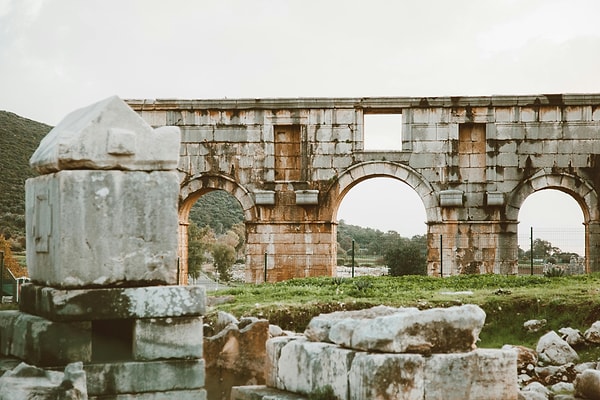
Patara, one of the largest and oldest cities of ancient Lycia, is located in the district of Kaş in Antalya. Referred to as ‘Patar’ in Hittite sources, the city was of great strategic and commercial importance as the only gateway to the sea from the Xanthos Valley. It also hosted the Lycian Union's assembly building, demonstrating its political influence.
During the Roman period, Patara was an important religious centre as an oracle of Apollo. It is also known that Saint Nicholas, known in the Christian world as ‘Santa Claus,’ was born and lived in this city.
The Triumphal Arch that greets visitors at the entrance to the ancient city of Patara gives them a sense of the splendour of this fascinating settlement from the very first step. Inside the city, structures such as the theatre, agora, granary, Corinthian temple, Vespasian Baths and council building are full of details that will enchant history lovers.
Patara dazzles not only with its history but also with its natural beauty. The famous 12 km long Patara Beach is also a breeding ground for Caretta-Caretta sea turtles. For this reason, Patara, which is also of ecological importance, offers a unique combination of nature and history.
6. Termessos Ancient City
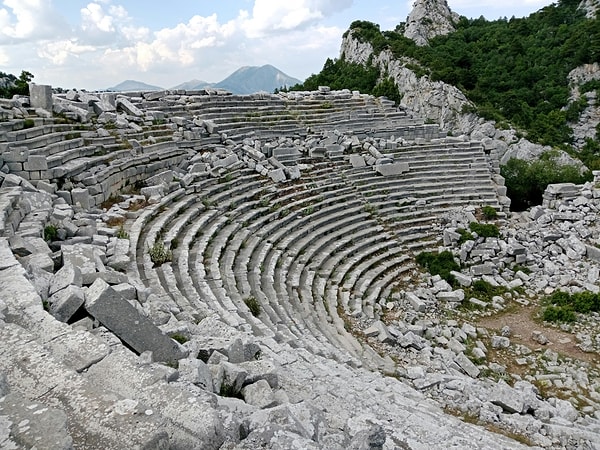
Located 30 km northwest of Antalya, within Güllük Mountain National Park, Termessos is nestled at an altitude of approximately 1,050 metres above sea level, hidden in the foothills of the Taurus Mountains, like an eagle's nest. Known as the ‘inaccessible city’ due to its unique location, Termessos offers visitors a fascinating atmosphere with its natural beauty and historical ruins.
The city, which belonged to the Pisidia region, was besieged by Alexander the Great in 334 BC but could not be conquered due to the difficult mountainous terrain. This event reinforced Termessos's reputation as a city of resistance throughout history.
To reach the ancient city, a short walk through pine forests is required. The 4,000–5,000-seat theatre located in the city is built on the valley and is memorable for both its architectural structure and the breathtaking views it offers. With its agora, gymnasium, cemetery areas (necropolis), tomb monuments, cisterns, and rock tombs, Termessos offers not only historical but also natural heritage.
With its extraordinary nature and well-preserved ruins, the ancient city of Termessos is a must-see destination for both history lovers and nature enthusiasts.
7. Olympos Ancient City
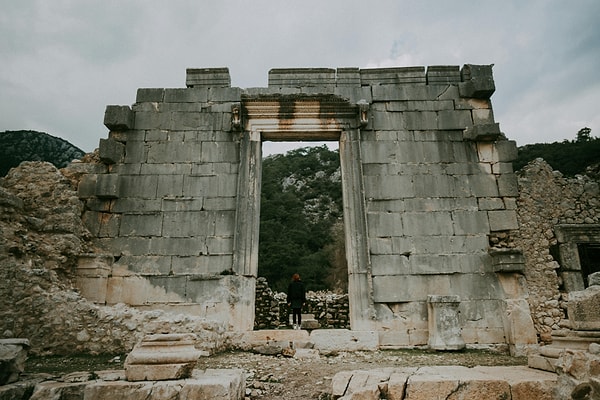
Located on the Mediterranean coast within the borders of the Kumluca district in Antalya, Olympos is an ancient city that stands out for both its natural beauty and mythological richness. One of the important port cities of the Lycian civilisation, Olympos takes its name from the high mountains surrounding it; in ancient sources, this mountain is referred to as ‘Mount Olympos’ and is described as the home of the gods.
Founded in the 2nd century BC, the city fell into the hands of pirates during the Roman period, but was later liberated and revived by the Roman Empire. The Olympos River, which flows through the city, extends to the ancient harbour, while the surrounding area contains ruins of temples, tombs, baths, a theatre and an agora.
Olympos is also known for its mythological legends. According to legend, the ‘Yanartaş’ (Chimaera), whose fire never goes out, is located on the mountainside here. This area, where natural gas still burns today, has had mystical significance since ancient times.
Nowadays, Olympos is a favourite destination for young travellers and nature lovers, offering a unique route for those who want to combine history, nature and a seaside holiday.
8. Phaselis Ancient City
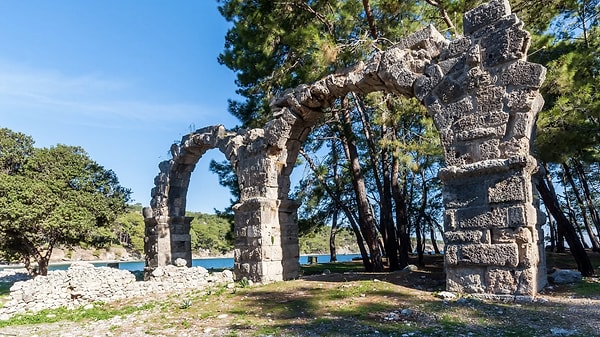
Located near Tekirova in the Kemer district of Antalya, right on the coast, Phaselis Ancient City attracts attention with its peaceful bays and pine forests intertwined with its historical atmosphere. The city, which was a strategic crossing point between the Lycia and Pamphylia regions, was founded by Rhodian colonists in the 7th century BC.
With three natural harbours in ancient times, the city was highly developed commercially. Phaselis maintained its influence during the Persian, Alexander the Great, Roman, and Byzantine periods, though it was occasionally targeted by pirates.
One of the most impressive features for visitors is the ancient main street that runs parallel to the sea. On either side of this street are the agora, theatre, baths, monumental arch, aqueducts and tombs. The remains of the ancient harbour also highlight Phaselis' importance in seafaring.
Today, Phaselis is an ideal destination for those seeking both historical exploration and nature walks, and with its seaside history, it can truly be described as a place where time stands still.
9. Myra Ancient City
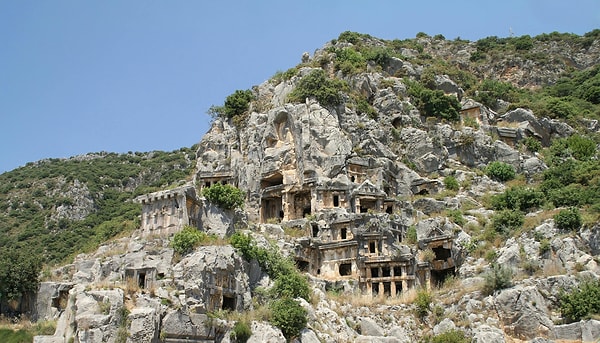
Located in the Demre district and one of the most important cities in the Lycian region, Myra is particularly known for its rock tombs and St. Nicholas Church. The city attracts attention with its history dating back to the 5th century BC and was one of six cities with three votes in the Lycian League.
One of its most famous structures is the multi-storey rock tombs carved into the side of steep cliffs. These tombs reflect the spirit of Lycian civilisation both architecturally and in terms of their symbolic meaning. Another prominent structure in Myra is a well-preserved theatre from the Roman period.
Myra also holds great significance in Christian history. Saint Nicholas, known as ‘Santa Claus,’ served as bishop here, and the church built in his name after his death has been preserved to this day. As the burial place of the saint, Myra is also a sacred pilgrimage site for Christian pilgrims.
The ancient city of Myra, which offers a combination of history, religion and architectural richness, is one of the places that best reflects Antalya's cultural diversity.
10. Ariassos Ancient City

Located 50 km northwest of Antalya, within the borders of the Döşemealtı district, Ariassos is situated in a mountainous and strategic valley in the Pisidia region. Although less known than other ancient cities, the uniqueness of its ruins and its structure, which is intertwined with nature, makes it worth exploring.
According to ancient sources, Ariassos was founded in the 3rd century BC. The city flourished during the Roman period, and visitors are particularly drawn to the magnificent monumental arch with three arches at the entrance. This arch is impressive both for its architectural elegance and its state of preservation.
Ariassos also features an agora, bath ruins, sarcophagi, residential buildings, and a necropolis area. The ancient city's location on the slopes of a mountain offers both a historical journey and breathtaking views as you explore.
With its tranquillity, unspoilt nature and harmony with the environment, Ariassos is an ideal destination for those seeking a peaceful historical journey away from the crowds.
Keşfet ile ziyaret ettiğin tüm kategorileri tek akışta gör!

Send Comment